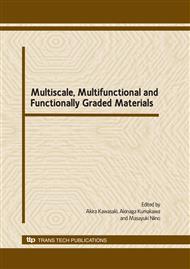p.9
p.17
p.23
p.29
p.35
p.41
p.47
p.53
p.59
Computational Evaluation of Effective Conductivity of Particulate Composites with Imperfect Interfaces
Abstract:
This paper is aimed to numerically evaluate the effective thermal conductivity of randomly distributed spherical particle composite with imperfect interface between the constituents. A numerical homogenization technique based on the finite element method (FEM) with representative volume element (RVE) was used to evaluate the effective properties with periodic boundary conditions. Modified random sequential adsorption algorithm (RSA) is applied to generate the three dimensional RVE models of randomly distributed spheres of identical size with the volume fractions up to 50%. Several investigations have been conducted to estimate the influence of the imperfect interfaces on the effective conductivity of particulate composite. Numerical results reveal that for the given composite, due to the existence of an interfacial thermal barrier resistance, the effective thermal conductivity depends not only on the volume fractions of the particle but on the particle size.
Info:
Periodical:
Pages:
35-40
Citation:
Online since:
October 2009
Authors:
Price:
Сopyright:
© 2010 Trans Tech Publications Ltd. All Rights Reserved
Share:
Citation:


